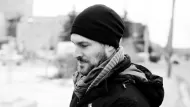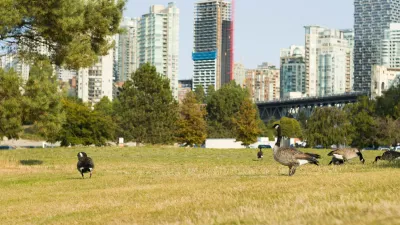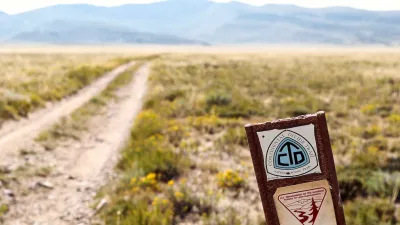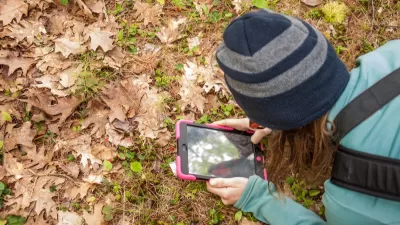The short-sightedness of overarching proclamations for the right city form obscures the very context in which cities are built and expanded. City planning must become reconnected to its environmental context.
Mixed-use, Smart Growth, Sustainability, Walkability, we have a tendency in urban planning to use generalizations for prescribing the right city form. These prescriptions are a response to failed planning policies that in part have led to the contemporary urban pandemics of obesity and greenhouse gas emissions correlating with auto-centric neighbourhoods. Although useful for translating often complex ideas into approachable means, these over-arching prescriptions can be insensitive to the geographies of difference, differences that ultimately expose our and nature’s nuances. Even if we agree on a better type of city form (i.e., mixed-use), neighbourhood planning cannot be smoothed out under a grand principle of explanation, e.g., mixed-use. Perhaps one of the shortcomings in realizing the right type of city form isn’t from a prescription’s lack of veracity, but rather failure to recognize the multitude of processes that inform developing the city.
Steven Flusty’s work on critiquing the often misuse of “globalization” provides a useful trajectory for problematizing the over-arching principles we often find in city planning. In De-Coca-Colonization: Making the Globe From the Inside Out he writes that the “global” is something commonly purported to be “out there.” It is supposedly unattached to lived experience. For Flusty, rather, the world starts with its inhabitants, their interpretations in the everyday realm, its apparent banality, and their aspirations to transcend it.
Flusty pursues stories and data from the quotidian to the theoretical to build the foundation of his conjecture. These are “the stuff from which the world is made, a rich panoply of stuff that more often than not yields a world of contradictory dynamics and polyvalent outcomes.” The meanings of an object, a story, a policy, or a type of neighbourhood design are based on their circumstance, their geographic and social context, their “lived experiential stories.” It’s from the stuff that the global is formed and experienced.
Working with the postulations of social theorist Michel Foucault we can further question the validity of over-arching principles. Foucault writes, if albeit opaquely, “The project of total history is one that seeks to reconstitute the overall form of a civilization, the principle – material or spiritual – of a society, the significance common to all the phenomena of a period, the law that accounts for their cohesion...” However, this “total history” that intends to expose an innate historical structure of a society is insensitive to the geographies of difference, the smoothing of which leads to significant long term repercussion: a history, a geography, a neighbourhood blind to the “lived experiential stories” and that of the natural environment.
Instead of totalizing observations and its commentators to construct a plot with a central core – e.g. mixed-use, Flusty seeks differences: an assemblage of discursive heterogeneous material elements of conversations, institutional programs, architectural forms, regulatory decisions, laws, administrative measures, scientific statements, philosophical propositions among myriad others. Working with sociologist Dorothy Smith, Flusty recognizes “the extent to which any one of my cases [institutional programs, architectural forms, etc] authoritatively typifies generalized social conditions is not at issue. Rather, each one constitutes both a ‘point of entry, the locus of an experiencing subject or subjects, into a larger social and economic process,’ and a vital component of those larger processes.” By assembling the stories of stuff in a city, from citizens working in their community garden to people and nature outside its geographic confines but affected by its influence, we move beyond the quest to divulge an inherent structure – an over-arching principle – and begin to recognize the value of geographical and social nuance. It is from here where Foucault requires that we look for the “multilinear ensembles of heterogeneous lines of power” in the everyday life experiences that inform decision making.
But there’s another character to add to the historical process of city development. The principles we’ve been prescribing tend to be human-centric or removed from environmental context. It is a grave shortcoming where the outcomes are slowly, and sometimes fatally, being felt. To broaden our perspective in the “rich panoply of stuff,” to use Flusty vernacular, how can we serve the environment? Instead of building the environment – adapting it to our means – how can we adapt to it and recognize it as part of the myriad stories? Through a lens of biodiversity we might be provided some insight.
The Convention on Biological Diversity recognizes the importance of biodiversity as the basis of our existence. It is essential for regulating our life support systems such as soil formation, the purification of water and clean air, the pollination of commercially valuable crops, as well as a source of spiritual enrichment, aesthetic quality and well-being. When we weave biodiversity into the story of a city, what can be our result?
Just last week the Cities and Biodiversity Outlook project released their book, Urbanization, Biodiversity and Ecosystem Services: Challenges and Opportunities. It is a collection of papers providing a global assessment on biodiversity conservation. It’s worth quoting one section at length:
The populations and economies of urban areas rely on hinterlands for resources, but there is a disconnect between using resources for urban areas and preserving or conserving ecosystem services [biodiversity]that are outside of urban areas. While it is recognized that urban areas and urban dwellers will need to begin to take greater responsibility for stewardship of Earth’s resources, urban sustainability efforts often are prone to localism, thus failing to take into account the need to conserve resources elsewhere.
Further,
Cities are interconnected globally through political, economic, and technical systems, and also through the Earth’s biophysical life-support systems. Cities also have disproportionate environmental impacts at the local, regional, and global scales well beyond their borders, yet they provide critical leadership in the global sustainability agenda. Although urbanized areas cover only a small portion of the surface of the planet [in Canada for example, ~0.2% of its surface area], they account for a vast share of anthropogenic impacts on the biosphere.
In brief, the context of city planning – and consumer practices in a city – has become uncoupled from its environmental context. The short-sightedness of overarching proclamations for the right city form obscures the very context in which cities are built and expanded. When we occlude context – difference – the rhetoric becomes totalizing and simply tied to a given ideological framework. By following the stories of stuff we can uncover not only a more just city, but one that does not submit to totalizing narratives of ideology.
The construction of ideology is for another article. But as to foreshadow we can follow Steven Flusty’s use of sociologist Arjun Appadurai and recognize that we must “follow the [stuff of the city], for their meanings are inscribed in their forms, their uses, their trajectories. It is only through the analysis of these trajectories that we can interpret the human transactions and calculations that enliven things.” In the complex set of relations in a city we assemble grids of intelligibility and in the process not produce “ideology” but rather local “truths.” We seek difference, not total histories.

Planetizen Federal Action Tracker
A weekly monitor of how Trump’s orders and actions are impacting planners and planning in America.

Map: Where Senate Republicans Want to Sell Your Public Lands
For public land advocates, the Senate Republicans’ proposal to sell millions of acres of public land in the West is “the biggest fight of their careers.”

Restaurant Patios Were a Pandemic Win — Why Were They so Hard to Keep?
Social distancing requirements and changes in travel patterns prompted cities to pilot new uses for street and sidewalk space. Then it got complicated.

Maui's Vacation Rental Debate Turns Ugly
Verbal attacks, misinformation campaigns and fistfights plague a high-stakes debate to convert thousands of vacation rentals into long-term housing.

San Francisco Suspends Traffic Calming Amidst Record Deaths
Citing “a challenging fiscal landscape,” the city will cease the program on the heels of 42 traffic deaths, including 24 pedestrians.

California Homeless Arrests, Citations Spike After Ruling
An investigation reveals that anti-homeless actions increased up to 500% after Grants Pass v. Johnson — even in cities claiming no policy change.
Urban Design for Planners 1: Software Tools
This six-course series explores essential urban design concepts using open source software and equips planners with the tools they need to participate fully in the urban design process.
Planning for Universal Design
Learn the tools for implementing Universal Design in planning regulations.
Heyer Gruel & Associates PA
JM Goldson LLC
Custer County Colorado
City of Camden Redevelopment Agency
City of Astoria
Transportation Research & Education Center (TREC) at Portland State University
Camden Redevelopment Agency
City of Claremont
Municipality of Princeton (NJ)






























